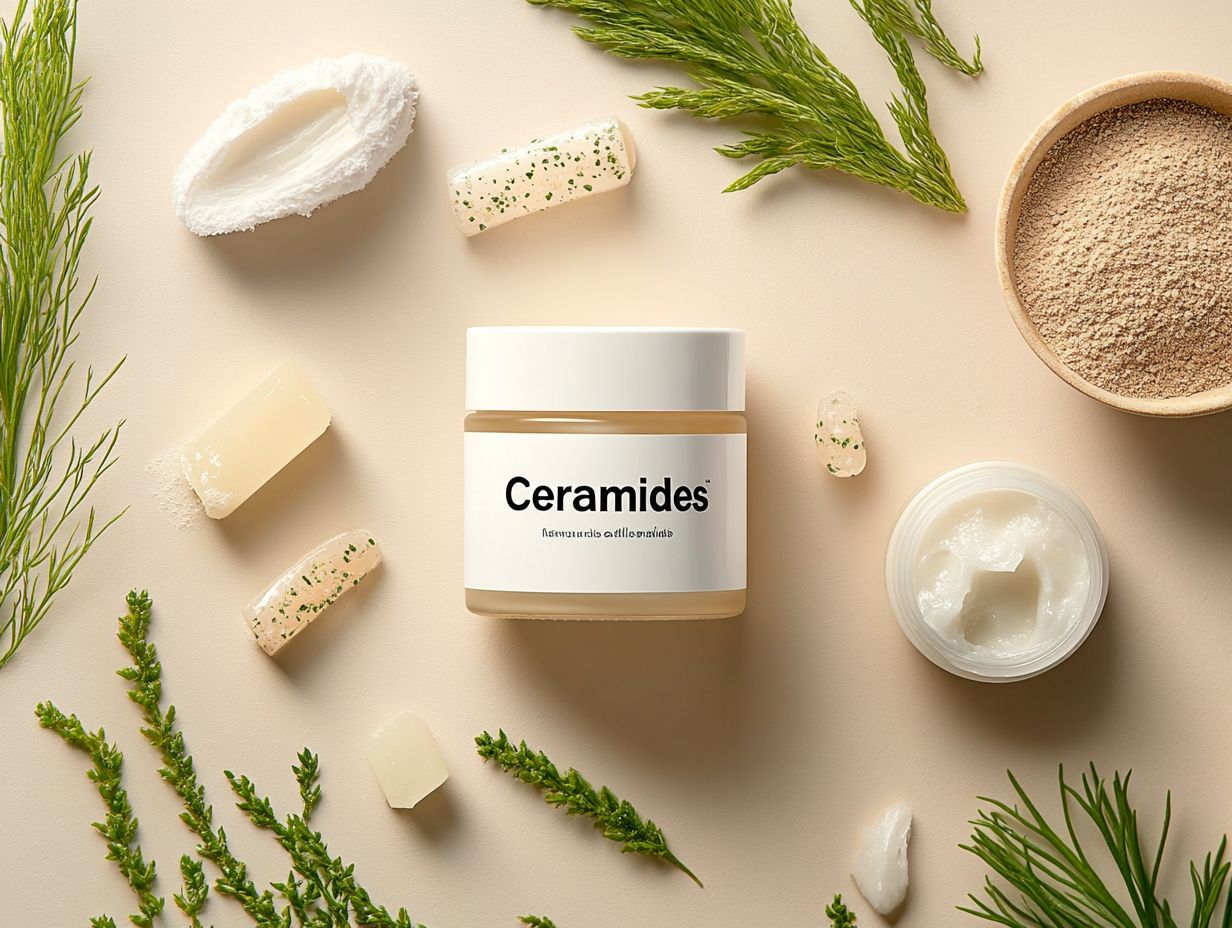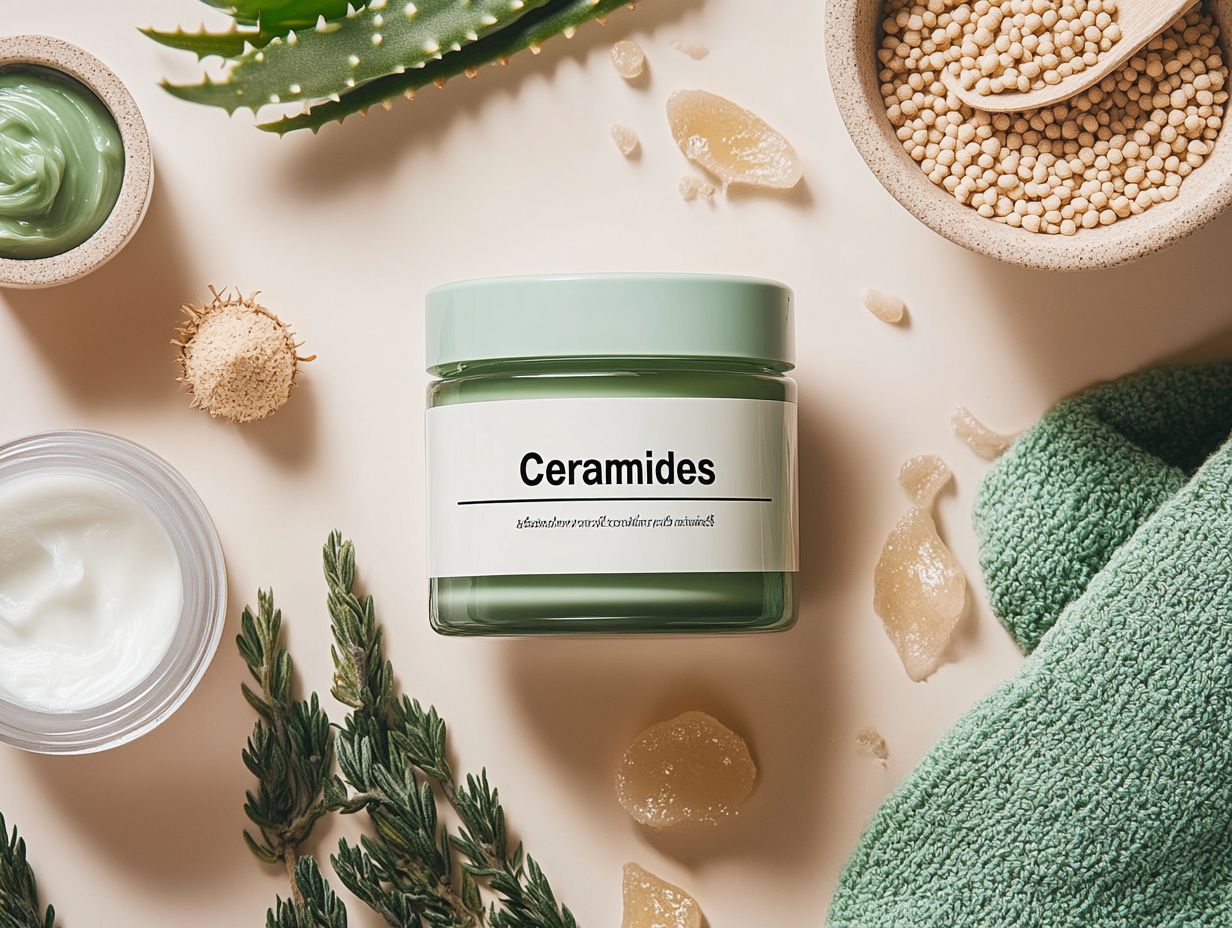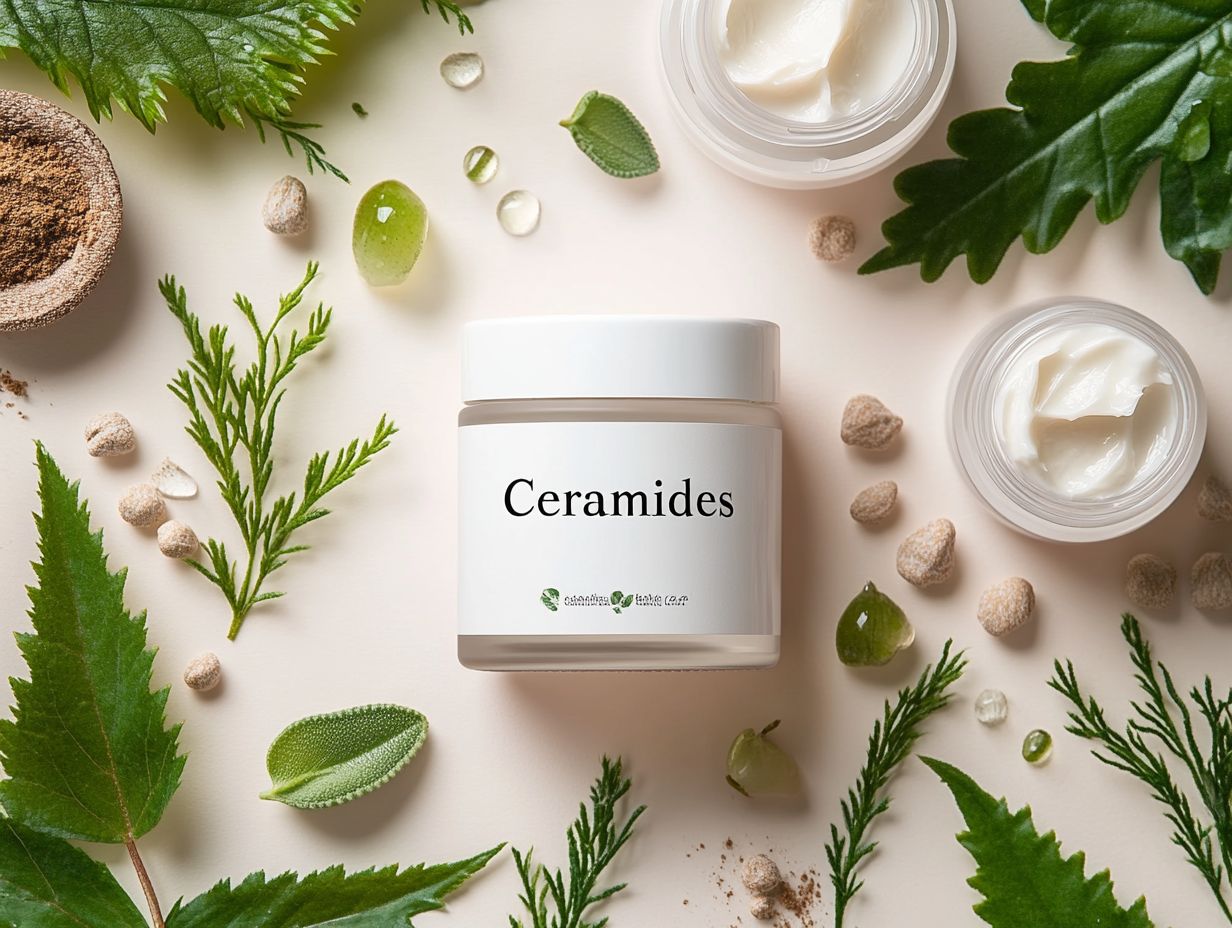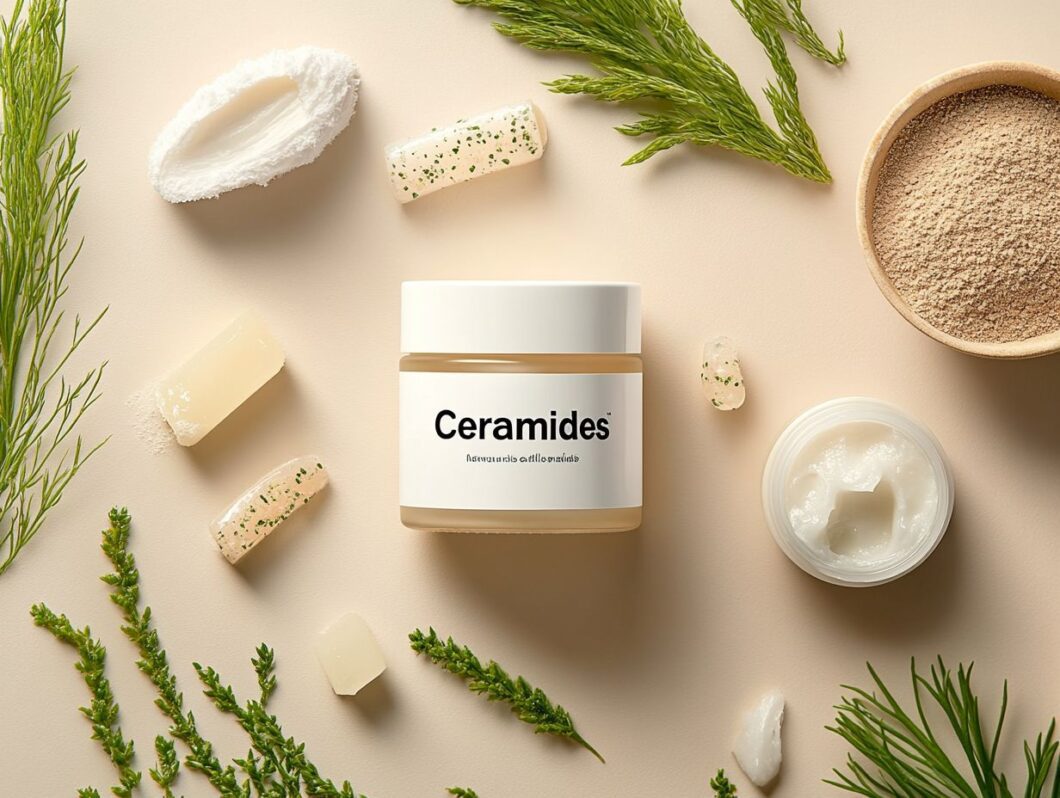Ceramides are essential lipids that play a crucial role in maintaining healthy skin. Recognized as a skincare powerhouse, they contribute significantly to strengthening the skin barrier, retaining moisture, and protecting against environmental stressors.
In this article, I will explore the importance of ceramides, how to identify deficiencies, and ways to incorporate these beneficial ingredients into your skincare routine. Additionally, I will discuss potential side effects and other natural methods to enhance ceramide levels for achieving radiant, resilient skin.
Key Takeaways:
What are Ceramides?

Ceramides are lipid molecules that I understand are naturally present in the skin, and they play a crucial role in maintaining skin hydration and ensuring a healthy skin barrier function.
As essential components of the skin’s protective barrier, they help retain moisture, protect against environmental damage, and support overall skin health.
However, with aging, I have observed that the natural production of ceramides may decline, resulting in dry skin and various conditions such as eczema and acne.
Recognizing the importance of ceramides is fundamental to creating effective skincare regimens that incorporate moisturizers and serums to replenish these vital lipids.
The Importance of Ceramides in Skincare
I recognize the importance of ceramides in skincare for maintaining skin moisture and ensuring a strong protective barrier against environmental toxins and damage.
Ceramides play a crucial role in a healthy skincare routine, as they help restore the skin barrier, improve hydration, and address the challenges of aging skin.
By incorporating ceramides into skincare products, such as moisturizers and serums, I can enhance skin health and protect against dryness and irritation.
How Ceramides Support Skin Health

I recognize that ceramides play a crucial role in supporting skin health by reinforcing the skin barrier function, which is essential for maintaining hydration and preventing moisture loss. As lipid molecules, ceramides effectively fill the gaps between skin cells, creating a robust protective barrier that defends against environmental damage, irritants, and allergens.
This protective effect not only enhances skin hydration but also promotes a smoother, more youthful appearance, which is particularly beneficial for aging skin.
Research has shown that ceramides can significantly assist individuals with conditions such as eczema and psoriasis by reducing inflammation and restoring the skin’s natural moisture balance. Dermatologists emphasize the importance of incorporating ceramide-rich products into one’s skincare regimen, as this can lead to notable improvements in skin texture and elasticity.
A study published in the Journal of Investigative Dermatology revealed that patients using ceramide creams reported enhanced hydration levels and reduced dryness.
Therefore, I understand that these essential lipids play a multifaceted role in fostering overall skin vitality, ensuring that the skin remains resilient against the daily challenges of modern life.
Signs of Ceramide Deficiency
I have observed that signs of ceramide deficiency can present as dry skin, an increased vulnerability to various skin conditions, and a weakened skin barrier, often resulting in issues such as eczema and acne.
As individuals age, the natural levels of ceramides in the skin tend to diminish, exacerbating these symptoms and contributing to a noticeable decline in skin health.
It is essential to recognize these signs early to facilitate timely intervention and effective treatment.
Identifying and Addressing Deficiencies

Identifying ceramide deficiencies involves recognizing the symptoms and consulting with a dermatologist, who can recommend suitable skin products for topical application. Common indicators I look for include persistent dry skin, irritation, and conditions like eczema.
To address these deficiencies, I often incorporate ceramide-rich products into my daily skincare routine, which helps restore both skin moisture and barrier function.
The expertise of a dermatologist is invaluable in diagnosing these issues, as they can conduct thorough assessments and propose tailored treatment plans. It is essential for me to communicate my symptoms and skin history to ensure a comprehensive evaluation.
When selecting effective skin products, I prioritize formulations that highlight ceramides as a key ingredient, since these compounds play a crucial role in strengthening the skin’s natural barrier. I also seek out moisturizers, serums, and ointments that include complementary ingredients like hyaluronic acid and fatty acids, as they enhance the hydrating effects.
Regular use of these formulations not only alleviates dryness but also fortifies the skin against environmental irritants.
How to Incorporate Ceramides into Skincare Routine
Incorporating ceramides into my skincare routine is both straightforward and highly beneficial, particularly through the use of moisturizers and serums designed to enhance skin hydration and barrier function.
I begin by selecting products that list ceramides as key ingredients, and I often opt for those that combine natural ceramides with hyaluronic acid for optimal efficacy.
By regularly applying these products, I can significantly improve my skin’s moisture levels and overall health.
Topical and Oral Options

When considering ceramide supplementation, I recognize that there are both topical and oral options available that can effectively enhance skin moisture and barrier function. Topical products, such as creams and serums, are designed for direct application to the skin, offering immediate benefits. In contrast, oral supplements may improve skin health from within by supporting overall lipid levels in the body.
Topical ceramides often feature formulations that combine these essential lipids with other beneficial ingredients like hyaluronic acid and glycerin to amplify hydration. Notable products, such as CeraVe’s Moisturizing Cream and The Ordinary’s Natural Moisturizing Factors + HA, exemplify how effective these formulations can be in restoring the skin’s protective barrier.
On the other hand, oral ceramide supplements are available in capsule or powdered form and aim to enhance skin hydration by complementing the body’s natural lipids. Brands such as SkinCeuticals and Dr. Mercola provide options designed to promote skin elasticity and smoothness from the inside out.
Ultimately, I believe that both methods can play vital roles in achieving radiant, healthy skin, depending on individual preferences and needs.
Potential Side Effects of Ceramides
While I recognize that ceramides are generally safe for most skin types, I am aware that potential side effects can arise, especially in individuals with sensitive skin or certain skin conditions.
It is essential for me to consult with a dermatologist before incorporating new ceramide-based products into my routine. This step ensures that these products are appropriate for my skin type and allows me to discuss any necessary precautions to prevent adverse reactions.
Understanding Risks and Precautions
I recognize that understanding the risks and precautions associated with ceramide use is essential for maintaining optimal skin health, particularly for individuals with specific skin conditions or sensitivities. It is important for me to be aware of the ingredients in ceramide products and how they align with my existing skincare routine to prevent any adverse reactions.
I understand that allergic reactions or irritation can occur, especially for those with sensitive skin or allergies. Therefore, I make it a priority to carefully examine labels for potential irritants.
To minimize risks, I choose products that are hypoallergenic and free from harsh additives like fragrances or alcohol, which can trigger sensitivity.
I also find that introducing these products gradually into my skincare regimen allows me to assess my skin’s response and make adjustments based on my individual tolerance levels. By taking these precautions, I can enjoy the benefits of ceramides while ensuring that my skin remains healthy and irritation-free.
Other Natural Ways to Boost Ceramide Levels
I can naturally boost my ceramide levels by making thoughtful nutritional choices and incorporating lifestyle factors that support skin health.
By consuming foods rich in healthy fats, such as avocados, nuts, and fatty fish, I can enhance my body’s natural ceramide production.
Additionally, maintaining adequate hydration and minimizing exposure to environmental toxins are crucial components of this process.
Nutritional and Lifestyle Factors
I understand that nutritional and lifestyle factors play a significant role in influencing ceramide levels and overall skin hydration. I prioritize a balanced diet rich in vitamins and fatty acids to promote natural ceramide production. Additionally, I recognize that habits such as getting adequate sleep, managing stress, and maintaining proper hydration are crucial for supporting skin barrier function and overall skin health.
To improve ceramide levels, I make sure to incorporate foods high in omega-3 fatty acids, like salmon, walnuts, and flaxseeds, as these are beneficial for skin health. I also include avocados and olives in my diet, as they provide healthy fats that enhance skin moisture. Staying hydrated by drinking plenty of water throughout the day further supports my skin’s natural barrier.
I find it equally important to prioritize sleep and integrate relaxation techniques, such as meditation or yoga, into my routine to reduce stress, which can negatively impact skin quality. Moreover, I engage in regular exercise to boost blood circulation, facilitating nutrient delivery to the skin and fostering optimal ceramide production.


